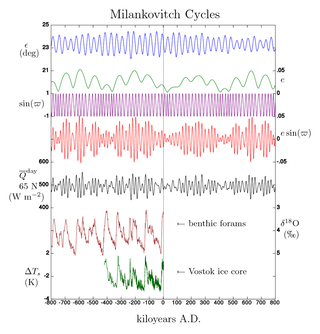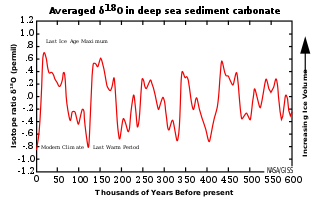

Cyclostratigraphy is a subdiscipline of stratigraphy that studies astronomically forced climate cycles within sedimentary successions. [1]


Cyclostratigraphy is a subdiscipline of stratigraphy that studies astronomically forced climate cycles within sedimentary successions. [1]
Astronomical cycles (also known as Milankovitch cycles) are variations of the Earth's orbit around the Sun due to the gravitational interaction with other masses within the Solar System. [1] Due to this cyclicity, solar irradiation differs through time on different hemispheres and seasonality is affected. These insolation variations have influence on Earth's climate and on the deposition of sedimentary rocks.
The main orbital cycles are precession with main periods of 19 and 23 kyr, obliquity with main periods of 41 kyr, and 1.2 Myr, and eccentricity with main periods of around 100 kyr, 405 kyr, and 2.4 Myr. [2] Precession influences how much insolation each hemisphere receives. Obliquity controls the intensity of the seasons. Eccentricity influences how much insolation the Earth receives altogether. Varied insolation directly influences Earth's climate, and changes in precipitation and weathering are revealed in the sedimentary record. The 405 kyr eccentricity cycle helps correct chronologies in rocks or sediment cores when variable sedimentation makes them difficult to assign. [1] Indicators of these cycles in sediments include rock magnetism, geochemistry, biological composition, and physical features like color and facies changes. [1] [3]
To determine the time range of a cyclostratigraphic study, rocks are dated using radiometric dating and other stratigraphic methods. Once the time range is calibrated, the rocks are examined for Milankovitch signals. From there, ages can be assigned to the sediment layers based on the astronomical signals they contain. [3]
Cyclostratigraphic studies of rock records can lead to accurate dating of events in the geological past, to increase understanding of cause and consequences of Earth's (climate) history, and to more control on depositional mechanisms of sediments and the acting of sedimentary systems. Cyclostratigraphy also aids the study of planetary physics, because it provides information of astronomical cycles that extends beyond 50 Ma (astronomical models are not accurate beyond this). [1] Assigning time ranges to these astronomical cycles can be used to calibrate 40Ar/39Ar dating. [3]
Uncertainties also arise when using cyclostratigraphy. Using radioisotope dating to set parameters for time scales introduces a degree of uncertainty. There are also stratigraphic uncertainties, uncertainties due to climate forcing, and uncertainty about Earth's rotational effects on its precession. There is also uncertainty in records extending beyond 50 Ma because astronomical models are not accurate beyond 50 Ma due to chaos and uncertainties of initial conditions. [1]

Sedimentary rocks are types of rock that are formed by the accumulation or deposition of mineral or organic particles at Earth's surface, followed by cementation. Sedimentation is the collective name for processes that cause these particles to settle in place. The particles that form a sedimentary rock are called sediment, and may be composed of geological detritus (minerals) or biological detritus. The geological detritus originated from weathering and erosion of existing rocks, or from the solidification of molten lava blobs erupted by volcanoes. The geological detritus is transported to the place of deposition by water, wind, ice or mass movement, which are called agents of denudation. Biological detritus was formed by bodies and parts of dead aquatic organisms, as well as their fecal mass, suspended in water and slowly piling up on the floor of water bodies. Sedimentation may also occur as dissolved minerals precipitate from water solution.

Milutin Milanković was a Serbian mathematician, astronomer, climatologist, geophysicist, civil engineer and popularizer of science.

Stratigraphy is a branch of geology concerned with the study of rock layers (strata) and layering (stratification). It is primarily used in the study of sedimentary and layered volcanic rocks. Stratigraphy has three related subfields: lithostratigraphy, biostratigraphy, and chronostratigraphy.

Milankovitch cycles describe the collective effects of changes in the Earth's movements on its climate over thousands of years. The term was coined and named after Serbian geophysicist and astronomer Milutin Milanković. In the 1920s, he hypothesized that variations in eccentricity, axial tilt, and precession combined to result in cyclical variations in the intra-annual and latitudinal distribution of solar radiation at the Earth's surface, and that this orbital forcing strongly influenced the Earth's climatic patterns.

James Croll, FRS, was a 19th-century Scottish scientist who developed a theory of climate variability based on changes in the Earth's orbit.
Orbital forcing is the effect on climate of slow changes in the tilt of the Earth's axis and shape of the Earth's orbit around the Sun. These orbital changes modify the total amount of sunlight reaching the Earth by up to 25% at mid-latitudes. In this context, the term "forcing" signifies a physical process that affects the Earth's climate.
Sequence stratigraphy is a branch of geology, specifically a branch of stratigraphy, that attempts to discern and understand historic geology through time by subdividing and linking sedimentary deposits into unconformity bounded units on a variety of scales. The essence of the method is mapping of strata based on identification of surfaces which are assumed to represent time lines, thereby placing stratigraphy in chronostratigraphic framework allowing understanding of the evolution of the earth's surface in a particular region through time. Sequence stratigraphy is a useful alternative to a purely lithostratigraphic approach, which emphasizes solely based on the compositional similarity of the lithology of rock units rather than time significance. Unconformities are particularly important in understanding geologic history because they represent erosional surfaces where there is a clear gap in the record. Conversely within a sequence the geologic record should be relatively continuous and complete record that is genetically related.

An interglacial period is a geological interval of warmer global average temperature lasting thousands of years that separates consecutive glacial periods within an ice age. The current Holocene interglacial began at the end of the Pleistocene, about 11,700 years ago.

The Quaternary glaciation, also known as the Pleistocene glaciation, is an alternating series of glacial and interglacial periods during the Quaternary period that began 2.58 Ma and is ongoing. Although geologists describe this entire period up to the present as an "ice age", in popular culture this term usually refers to the most recent glacial period, or to the Pleistocene epoch in general. Since Earth still has polar ice sheets, geologists consider the Quaternary glaciation to be ongoing, though currently in an interglacial period.
Cyclic sediments are sequences of sedimentary rocks that are characterised by repetitive patterns of different rock types (strata) or facies within the sequence. Processes that generate sedimentary cyclicity can be either autocyclic or allocyclic, and can result in piles of sedimentary cycles hundreds or even thousands of metres thick. The study of sequence stratigraphy was developed from controversies over the causes of cyclic sedimentation.

The 100,000-year problem of the Milankovitch theory of orbital forcing refers to a discrepancy between the reconstructed geologic temperature record and the reconstructed amount of incoming solar radiation, or insolation over the past 800,000 years. Due to variations in the Earth's orbit, the amount of insolation varies with periods of around 21,000, 40,000, 100,000, and 400,000 years. Variations in the amount of incident solar energy drive changes in the climate of the Earth, and are recognised as a key factor in the timing of initiation and termination of glaciations.

Marine Isotope Stage 11 or MIS 11 is a Marine Isotope Stage in the geologic temperature record, covering the interglacial period between 424,000 and 374,000 years ago. It corresponds to the Hoxnian Stage in Britain.

In celestial mechanics, apsidal precession is the precession of the line connecting the apsides of an astronomical body's orbit. The apsides are the orbital points farthest (apoapsis) and closest (periapsis) from its primary body. The apsidal precession is the first time derivative of the argument of periapsis, one of the six main orbital elements of an orbit. Apsidal precession is considered positive when the orbit's axis rotates in the same direction as the orbital motion. An apsidal period is the time interval required for an orbit to precess through 360°, which takes Earth's orbit about 112,000 years, completing a cycle and returning to the same orientation.
Lorraine Lisiecki is an American paleoclimatologist. She is a professor in the Department of Earth Sciences at the University of California, Santa Barbara. She has proposed a new analysis of the 100,000-year problem in the Milankovitch theory of climate change. She also created the analytical software behind the LR04, a "standard representation of the climate history of the last five million years".

André Léon Georges Chevalier Berger is a Belgian climatologist and professor. He is best known for his significant contribution to the renaissance and further development of the astronomical theory of paleoclimates and as a cited pioneer of the interdisciplinary study of climate dynamics and history.
North African climate cycles have a unique history that can be traced back millions of years. The cyclic climate pattern of the Sahara is characterized by significant shifts in the strength of the North African Monsoon. When the North African Monsoon is at its strongest, annual precipitation and consequently vegetation in the Sahara region increase, resulting in conditions commonly referred to as the "green Sahara". For a relatively weak North African Monsoon, the opposite is true, with decreased annual precipitation and less vegetation resulting in a phase of the Sahara climate cycle known as the "desert Sahara".

Terraces can be formed in many ways and in several geologic and environmental settings. By studying the size, shape, and age of terraces, one can determine the geologic processes that formed them. When terraces have the same age and/or shape over a region, it is often indicative that a large-scale geologic or environmental mechanism is responsible. Tectonic uplift and climate change are viewed as dominant mechanisms that can shape the earth’s surface through erosion. River terraces can be influenced by one or both of these forcing mechanisms and therefore can be used to study variation in tectonics, climate, and erosion, and how these processes interact.
The Sadler effect describes variation in apparent sediment accumulation rates and bed thicknesses back through time inherent to the geological sedimentary record. Peter Sadler analysed what structure you would expect in a stratigraphic section under the hypothesis that bigger geological events – episodes of deposition, erosion, and the gaps between those events – are rarer. He showed that under these conditions it is inevitable that, on average, thinner stratigraphic sections, which cover shorter amounts of time, record faster accumulation rates than thicker sections, which record longer amounts of time.

Lawrence Alexander Hardie was an American geologist, sedimentologist, and geochemist.
The Mid-Cenomanian Event (MCE) was an oceanic anoxic event that took place during the middle Cenomanian, as its name suggests, around 96.5 Ma.